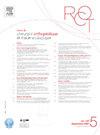Quel traitement choisir dans les fractures de l’acétabulum du sujet âgé : ostéosynthèse, ostéosynthèse-prothèse ou traitement orthopédique ? Résultats rétrospectifs à 2 ans d’un algorithme thérapeutique
Q4 Medicine
Revue de Chirurgie Orthopedique et Traumatologique
Pub Date : 2025-02-01
DOI:10.1016/j.rcot.2024.10.006
引用次数: 0
Abstract
Introduction
Les fractures de l’acétabulum représentent 7 % des fractures ostéoporotiques avec un pic épidémiologique situé entre 75 et 80 ans. L’objectif de cette étude est d’évaluer les résultats du traitement de ces fractures au sein d’une population âgée de plus de 65 ans.
Hypothèse
Le traitement chirurgical permettrait de meilleurs résultats sur la survie et la fonction dans la prise en charge des fractures de l’acétabulum des sujets âgés de plus de 65 ans.
Matériel et méthodes
Les patients de plus de 65 ans traités pour une fracture de l’acétabulum entre janvier 2017 et mai 2020 ont été inclus dans cette étude monocentrique rétrospective et divisés en trois groupes de traitement : ostéosynthèse, ostéosynthèse-prothèse de hanche (Ostéosynthèse-PTH) et traitement orthopédique. Le choix du traitement était fait selon un algorithme décisionnel dépendant des comorbidités et de l’autonomie du patient ainsi que des lésions osseuses. Le critère de jugement principal était la survie des patients à 12 et 24 mois de suivi.
Résultats
Quatre-vingt-quatorze patients (âge moyen de 78,5 ± 8,4 ans) ont été inclus : 29 patients traités par traitement orthopédique, 46 patients par ostéosynthèse et 19 patients par ostéosynthèse-PTH. Le suivi moyen est de 32,7 ± 14,9 mois. Les taux de mortalité étaient plus élevés dans les groupes traitement orthopédique et ostéosynthèse-PTH (respectivement 20,7 % et 21,1 %). Les patients des groupes traitement orthopédique et ostéosynthèse-PTH présentaient une surmortalité avec, respectivement, un hazard ratio (HR) de 3,4 ([1,02 ; 11,3], p < 0,05) et 3,3 ([0,9 ; 12,3], p = 0,08) par rapport à ceux traités par ostéosynthèse. Le PMA moyen à 2 ans, le score de Harris moyen à 2 ans et le score de Parker étaient significativement plus élevés dans les groupes opérés. Le taux de conversion en prothèse totale de hanche (PTH) était plus élevé dans le groupe traitement orthopédique (27,6 %). Le taux de complications s’élevait à 24 % (11/46) pour le groupe ostéosynthèse, 42 % (8/19) pour le groupe ostéosynthèse-PTH.
Discussion
En appliquant notre algorithme décisionnel, le traitement orthopédique est inférieur au traitement chirurgical en termes de survie et de résultats fonctionnels avec un taux de réintervention pour PTH supérieur au traitement par ostéosynthèse. Cette étude confirme la place de l’ostéosynthèse, avec des scores fonctionnels plus élevés, des taux de complications et de reprises plus faibles ainsi qu’un effet positif sur la mortalité.
Niveau de preuve
IV ; étude de cohorte rétrospective.
Introduction
Acetabular fractures account for 7% of osteoporotic fractures, with an epidemiological peak between 75 and 80 years of age. The aim of this study is to evaluate the results of treatment of these fractures in a population aged over 65.
Hypothesis
Surgical treatment would lead to better survival and functional outcomes in the management of acetabular fractures in subjects aged over 65.
Material and methods
Patients over 65 years of age treated for acetabular fracture between January 2017 and May 2020 were included in this retrospective single-center study and divided into three treatment groups: osteosynthesis, osteosynthesis-THA (Osteosynthesis-THA) and orthopedic treatment. The choice of treatment was made according to an algorithm that considered the patient's co-morbidities, autonomy and bone lesions. The primary endpoint was patient survival at 12 and 24 months’ follow-up.
Results
Ninety-four patients (mean age 78.5 ± 8.4 years) were included: 29 patients treated with orthopedic therapy, 46 patients with osteosynthesis and 19 patients with osteosynthesis-THA. Mean follow-up was 32.7 ± 14.9 months. Mortality rates were higher in the orthopedic and osteosynthesis-THA groups (20.7% and 21.1% respectively). Patients in the orthopedic and osteosynthesis-THA groups showed excess mortality, with hazard ratios (HR) of 3.4 ([1.02; 11.3], P < 0.05) and 3.3 ([0.9; 12.3], P = 0.08) respectively, compared with those treated with osteosynthesis. Mean PMA at 2 years, mean Harris score at 2 years and Parker score were significantly higher in the operated groups. The rate of conversion to THA (THA) was higher in the orthopedic treatment group (27.6%). The complication rate was 24% (11/46) for the osteosynthesis group, 42% (8/19) for the osteosynthesis-THA group.
Discussion
Applying our decision algorithm, orthopedic treatment is inferior to surgical treatment in terms of survival and functional results, with a higher re-intervention rate for THA than treatment with osteosynthesis. This study confirms the place of osteosynthesis, with higher functional scores, lower complication and revision rates, and a positive effect on mortality.
Level of evidence
IV; retrospective cohort study.
对于老年人的乙酰球骨折,我应该选择什么治疗:骨合成、骨合成假体还是骨科治疗?治疗算法两年后的回顾性结果
l’acétabulum IntroductionLes骨折占7%的骨折与流行病学顶峰位于75 - 80岁之间。本研究的目的是评价这些骨折治疗的结果,在一个人口超过65 ans.HypothèseLe手术治疗才能生存和功能上表现最好的照顾l’acétabulum骨折的患者年龄超过65 ans.Matériel受试者和méthodesLes的2017年1月至2020年5月期间接受乙酰球骨折治疗的65岁以上患者包括在本单中心回顾性研究中,并分为三组治疗:骨合成、髋部骨合成(Osteosynthese -PTH)和骨科治疗。治疗的选择是根据一种决策算法做出的,该决策算法依赖于患者的共病和自主性以及骨损伤。主要的判断标准是患者在12个月和24个月的随访后的生存。结果包括94例患者(平均年龄78.5±8.4岁):29例骨科治疗患者,46例骨合治疗患者,19例骨合- pth治疗患者。平均随访时间为32.7±14.9个月。骨科治疗组和骨合治疗-PTH组的死亡率较高(分别为20.7%和21.1%)。骨科治疗组和骨合成-PTH组的患者死亡率分别为3.4 ([1.02;11,3], p。0.05)和3.3 ([0.9;12.3], p = 0.08)与骨合成治疗相比。在手术组中,平均2岁ADP,平均2岁Harris和Parker得分明显更高。骨科组的全髋关节置换率(PTH)更高(27.6%)。骨合成组并发症发生率为24%(11/46),骨合成-PTH组并发症发生率为42%(8/19)。通过应用我们的决策算法,骨科治疗在生存率和功能结果方面低于手术治疗,PTH再干预率高于骨合成治疗。这项研究证实了骨合成的重要性,它具有更高的功能分数,更低的并发症和复发率,以及对死亡率的积极影响。证据等级IV;回顾性队列研究。骨质疏松性骨折占骨质疏松性骨折的7%,流行病学高峰在75 - 80岁之间。本研究的目的是评估65岁以上人群骨折治疗的结果。假设手术治疗可改善65岁以上受试者髋部骨折的生存率和功能结果。本回顾性单中心研究包括2017年1月至2020年5月期间接受髋部骨折治疗的65岁以上患者,并分为三个治疗组:骨合成、骨合成- tha(骨合成- tha)和骨科治疗。治疗的选择是根据一种算法做出的,该算法考虑了患者的共发病、自主性和骨损伤。主要终点为12个月和24个月随访患者生存率。结果94例患者(平均年龄78.5±8.4岁):29例接受骨科治疗,46例接受骨融合治疗,19例接受骨融合- tha治疗。平均随访为32.7±14.9个月。骨科和骨合成- tha组的死亡率较高(分别为20.7%和21.1%)。骨科和骨合成- tha组患者死亡率过高,风险比(HR)为3.4 ([1.02;11.3], P & L。0.05)和3.3 ([0.9;12.3], P = 0.08),与接受骨合成治疗的患者相比。平均PMA在2岁,平均哈里斯在2岁,帕克在手术组的得分明显更高。骨科治疗组的THA转化率较高(27.6%)。骨合成组的并发症率为24%(11/46),骨合成- tha组的并发症率为42%(8/19)。讨论应用我们的决策算法,骨科治疗在生存率和功能结果方面低于外科治疗,THA的再干预率高于骨合成治疗。这项研究证实了骨合成的位置,具有较高的功能分数,较低的并发症和修正率,并对死亡率有积极的影响。证据等级IV;回顾性队列研究。
本文章由计算机程序翻译,如有差异,请以英文原文为准。
求助全文
约1分钟内获得全文
求助全文
来源期刊

Revue de Chirurgie Orthopedique et Traumatologique
Medicine-Surgery
CiteScore
0.10
自引率
0.00%
发文量
301
期刊介绍:
A 118 ans, la Revue de Chirurgie orthopédique franchit, en 2009, une étape décisive dans son développement afin de renforcer la diffusion et la notoriété des publications francophones auprès des praticiens et chercheurs non-francophones. Les auteurs ayant leurs racines dans la francophonie trouveront ainsi une chance supplémentaire de voir reconnus les qualités et le intérêt de leurs recherches par le plus grand nombre.
 求助内容:
求助内容: 应助结果提醒方式:
应助结果提醒方式:


